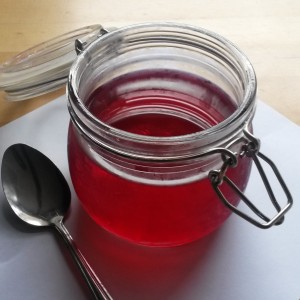Every year at this time, I attempt to preserve the mind-blowing aroma of the tea roses in our front yard. This is inevitably followed by me throwing out the untouched rose-infused products I made the year before. Previous experiments with rose water and simple syrup infused with rose petals were charming, but quaint isn’t really my cooking style, so I never worked them into a recipe. I can only imagine the look of surprise on Jeff’s face if I spritzed rose water on our linens, and then his sleep-deprived scowl after a night of my constant sneezes. Last year I made some very nice Rose Scented Almond Milk. It was good enough that I included it in the book. But milks don’t keep.
 My compulsion for preserving the roses is threefold. 1) Our antique rose bush produces, without question, the most aromatic blossoms I have ever come across. I’ve shared them with several chef friends who say the same. 2) The fresh flowers make me sneeze. I can decorate with one or two, but I can’t overfill a vase with their glorious fecundity and bring it inside. 3) The half-wild, wholly-neglected plant blooms and blows faster than most. We get about 2 weeks of prime rose season. Since there’s a fifty percent chance of rain during that time, drying the blossoms has never been a viable option.
My compulsion for preserving the roses is threefold. 1) Our antique rose bush produces, without question, the most aromatic blossoms I have ever come across. I’ve shared them with several chef friends who say the same. 2) The fresh flowers make me sneeze. I can decorate with one or two, but I can’t overfill a vase with their glorious fecundity and bring it inside. 3) The half-wild, wholly-neglected plant blooms and blows faster than most. We get about 2 weeks of prime rose season. Since there’s a fifty percent chance of rain during that time, drying the blossoms has never been a viable option.
Using flowers as an ingredient can be a dodgy prospect. I love hibiscus and saffron. The peppery bite of nasturtiums, and the explosive color of calendula and borage blossoms are lively additions to summer salads, but things can take an ugly turn when flowers are used as a novelty or coquette. Don’t serve me lavender. The scent of Grandma’s drawer sachet will never be welcome on my plate. Rose walks a fine line, perhaps because it has historically been used as an ingredient for as long as it has a perfume. I appreciate rose when it is used with a steady hand and clear intention.
I was determined that this year’s roses were going to be made into something I would actually use. The recipe I landed on is an Indian Rose Syrup. I scrapped together several ideas from YouTube videos. (Another obsession.) The flavor and aroma of the flowers is deepened with cardamom and freshened with basil, mint and cilantro. Adding a bit of grated beet makes the syrup more colorful and festive. The bright pink syrup is diluted with water and lemon and poured over ice to make a cooling beverage called sherbet. Sometimes yogurt, milk, or nut milk is used. Bright pink rose milk is served at weddings in several Asian countries.
I’m very pleased with the results and I’m confident that it will be long gone by the time next year’s blossoms appear. This summer looks like it will be a scorcher. I’ll serve tall, icy glasses of syrup laced lemon water in the shady gazebo. It will definitely be used as a cocktail mixer. Last night’s shaker of vodka, rose syrup, and lemon juice went down mighty easy. There was no hint of parlor music or antique lace. If the syrup doesn’t get guzzled this summer, it might end up in a sorbet or Middle Eastern dessert. A sauce made with sliced strawberries would go well on vanilla ice cream or poppy seed cake. But… I do like pink drinks.
UPDATE: My beloved syrup got moldy. I had to throw it out. Luckily I have some stashed in the freezer.

Indian Rose Syrup
2 ½ cups water
2 ½ cup cane sugar
6-7 cardamom pods, cracked in a mortar
1 tablespoon grated beet
4 oz. / 115 g aromatic, unsprayed rose petals, from about 10-12 big tea roses
8-10 basil leaves, coarsely chopped
8-10 mint leaves, coarsely chopped
2-3 cilantro sprigs, coarsely chopped
Combine the sugar and water in a medium saucepan over medium low heat. Swirl the pan now and then until the sugar is completely melted. Add the cardamom and beet and increase the heat to medium high. Boil the syrup for 5 minutes. Set aside.
Combine the blossoms, basil, mint, and cilantro in a large bowl. Using gloves (to prevent delayed contact sneezing) knead and bruise the blossoms until they are about half the volume. Pour on the hot syrup and stir to mix. Cover with plastic wrap and leave to infuse overnight, or at least 6 hours.
Place a large sieve over a container and strain the syrup, pressing gently on the blossoms, but not rubbing them against the sieve. Store refrigerated in a sealed container for… we’ll see how long it lasts! I froze a few cups. Hopefully it will maintain the clarity and fresh flavor and be the winter treat I’ve been hoping for.
Yield: 4 cups.
TRAGIC UPDATE: My fresh syrup got moldy after a week. Luckily I froze some.

